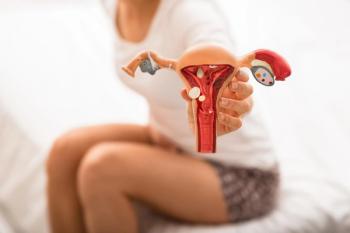
Suturing Techniques in Laparoscopic Surgery
OBGYN.net Conference CoverageFrom ISGE - Montreal, Canada - April, 1999
Dr. Carter: "Hello, I'm Dr. Jim Carter, and I'm here in Montreal at the International Society of Gynecologic Endoscopy, which is a truly international society with representatives from India, Japan, China, Taiwan, and throughout the world. Today we are honored to have with us, Dr. Prashant Mangeshikar. Dr. Prashant has been a very good friend, colleague, and a teacher for me as well - in endoscopic techniques. With his tremendous knowledge, he produces in India his own newsletter published with the Microsoft 98 Publishing System, providing information throughout India on gynecologic techniques. Dr. Prashant, could you illuminate for us some of your work in India in laparoscopic surgery? I know they call you the "flying endoscopist" because you go to so many places there."
Dr. Mangeshikar: "Thanks Jim. The idea of trying to spread the knowledge of endoscopic surgery stemmed after my return from Germany where I did my fellowship with Professor Semm. At that time, nobody was really doing any endoscopic surgery in India, so I thought why not try and spread the knowledge by moving around from place to place. Initially I started doing workshops all across the country from the north to the south and eastern to western borders, and by now, I've finished over 150 workshops training and teaching people the tips and tricks of endoscopic surgery. But the idea of this newsletter came about because I was tired from traveling - so why not put everything down on paper, and put in your knowledge so that it can reach the thousands of other gynecologists to whom this kind of surgery was not accessible. We are a society of over 13,000 gynecologists registered with our Federation of Obstetrics and Gynecologic Society of India. That's how the idea of this newsletter came around."
Dr. Carter: "That's wonderful, so Prashant uses his newsletter as a way to communicate to the other people and has taught, I think you said 150 large programs. In your laparoscopic surgery, you mentioned some tips and pearls that you have. Could you give us two or three of your tips?"
Dr. Mangeshikar: "First hand, most are the entry techniques that are common whether you do a diagnostic laparoscopy or a operative laparoscopy - how to get in safely and effectively without causing any damage to the tissues, and that you could get a good view without any bleeding around from the sides. That's what I really teach at each and every workshop whether it is the basic or an advanced level surgery. My main focus is on suturing because in our country where we have problems with funds, we can't really play around with lasers and stapling devices. So we go back to age-old suturing, and since the suture material is available, which you use at laparotomy, we use the same material without any special tricks for doing laparoscopic suturing. So our main focus has been on suturing skills, and I train people in labs to do the suturing very effectively."
Dr. Carter: "Now this is a tremendous commitment that Prashant makes to his colleagues to give them this information. Prashant, can you tell me how many hours are you spending a week with your practice and teaching, and yet - you also have your family. I know you traveled here with your son who is traveling around to see the sights. It's a wonderful thing that you're doing for people."
Dr. Mangeshikar: "I hope my family is not listening, but I spend most of my time traveling, teaching, and operating in practice, and so there's actually little time for my family, but they hold on and I hold on to them, so we are a happy family."
Dr. Carter: "What surgical procedure do you prefer? What is your most enjoyable procedure per say?"
Dr. Mangeshikar: "My most enjoyable procedure is myomectomies."
Dr. Carter: "Myomectomies - could you describe for us your technique?"
Dr. Mangeshikar: "It's the removal of myoma with effective hemostasis, you don't want to have too much of a blood loss and suturing, and as I emphasize - one must learn to suture before one really does laparoscopic surgery. You cannot do laparoscopic surgery without knowing how to suture because the main stay is suturing, and to quote Howard Topel, "The future has been with the suture."
Dr. Carter: "I think that we have found emphasized in this conference through the work of Dr. Dubuisson in France, and now my colleague, Prashant from India, that suturing is key to laparoscopic surgery, and all of us need to concentrate on our skills in suturing at laparoscopic surgery, and to learn from our colleagues who have advanced this knowledge so well. Thank you very much Prashant."
Dr. Mangeshikar: "Thank you Jim, and thanks to all at OBGYN.net and many greetings to all of you across the world."
Newsletter
Get the latest clinical updates, case studies, and expert commentary in obstetric and gynecologic care. Sign up now to stay informed.










